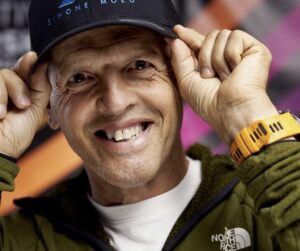Constant snow falling on Manaslu has pushed everyone away. “[In the] last week we had almost three metres of snow, so we decided to get everyone down to Samagaon, all the Sherpas, all the climbers, the whole group,” Simone Moro reported on Saturday.
Two helicopters evacuated most of the expedition members, although a few, including Sophie Lenaerts and Stef Maginelle of Belgium, walked down to the village. “The descent from Base Camp was a bit dangerous because of snow slides,” they reported.

Samagaon from the air on Friday. Photo: Alex Txikon
“[Of all my] 21 winter expeditions, this one is proving to be particularly hard,” Simone Moro admitted.
Unlike the rest of the climbers, who settled in Samagaon, Alex Txikon, Moro, and two others flew all the way back to Kathmandu. Here, they are arranging to fly a resupply of oxygen and cooking fuel to BC. They themselves will wait for conditions to improve before returning to Base Camp. “This is not possible at the moment,” Moro wrote.

A hardly visible tent in Manaslu Base Camp. Photo: Simone Moro
A different winter strategy
The two winter teams currently in Nepal are using lower and more comfortable retreats as part of their expedition strategy. Jost Kobusch, on his solo attempt on Everest, has chosen to walk the extra distance to Lobuche for his rest-and-recovery periods. On the Khumbu glacier, he pitched a small tent at the beginning of the climbing route to the Lho La. Yet, Kobusch has managed to reach 6,400m so far, pitch a second tent on top of the col, and possibly a third one at the highest point that he reached so far, 6,400m on the West Ridge.

Alex Txikon and Cheppal Sherpa sort out extra supplies at Seven Summit Trek’s storehouse. Photo: Alex Txikon
The bigger team on Manaslu is either trekking or using helicopters to move swiftly between Base Camp and Samagaon village during heavy snowfalls.
This is undoubtedly an advantage for the climbers attempting Manaslu. This way, they avoid the strain of relentless exposure to extreme cold. They also don’t have to dig out their tents constantly. Instead, they enjoy instead warm, comfortable premises.
The problem is that they need to gain altitude as soon as possible, both to acclimatize and to push forward the route. After 18 days, they have been still unable to set up Camp 2.

Tricky conditions above Camp 1 before the latest snowstorm. Photo (from January 5) by Oswald R. Pereira
As Oswald Rodrigo Pereira points out, difficult conditions thwarted the team’s progress even before the latest snowstorm.”The route above C1 turned out to be a nightmare: crevasses, but mainly unbelievable amounts of snow,” he wrote about his January 4 foray. “After three hours of really tough work, [our team] made 200m vertical, reaching 6,000m before we had to return.”






